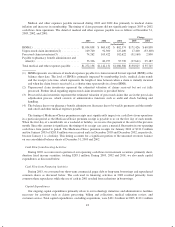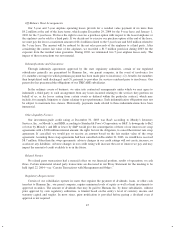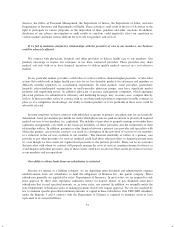Humana 2003 Annual Report Download - page 61
Download and view the complete annual report
Please find page 61 of the 2003 Humana annual report below. You can navigate through the pages in the report by either clicking on the pages listed below, or by using the keyword search tool below to find specific information within the annual report.
be brought on behalf of health care providers. This suit alleges breaches of federal statutes, including ERISA
and RICO.
In addition, because of the nature of the health care business, we are subject to a variety of legal actions
relating to our business operations, including the design, management and offering of products and services.
These include and could include in the future:
• claims relating to the methodologies for calculating premiums;
• claims relating to the denial of health care benefits;
• challenges to the use of some software products used in administering claims;
• medical malpractice actions based on our medical necessity decisions or brought against us on the
theory that we are liable for our providers’ alleged malpractice;
• allegations of anti-competitive and unfair business activities;
• provider disputes over compensation and termination of provider contracts;
• disputes related to self-funded business, including actions alleging claim administration errors;
• claims related to the failure to disclose some business practices; and
• claims relating to customer audits and contract performance.
In some cases, substantial non-economic or punitive damages as well as treble damages under the federal
False Claims Act, RICO and other statutes may be sought. While we currently have insurance coverage for some
of these potential liabilities, other potential liabilities may not be covered by insurance, insurers may dispute
coverage or the amount of insurance may not be enough to cover the damages awarded. Additionally, the cost of
business insurance coverage has increased significantly. As a result, we have increased the amount of risk that we
self-insure, particularly with respect to matters incidental to our business. We believe that we are adequately
insured for claims in excess of our self-insurance. However, some types of damages, like punitive damages, may
not be covered by insurance, particularly in those jurisdictions in which coverage of punitive damages is
prohibited. Insurance coverage for all or some forms of liability may become unavailable or prohibitively
expensive in the future.
A description of material legal actions in which we are currently involved is included under “Legal
Proceedings” of Item 3 in Part I. We cannot predict the outcome of these suits with certainty, and we are
incurring expenses in the defense of these matters. In addition, recent court decisions, including some that erode
protections under the Employee Retirement Income Security Act, or ERISA, and legislative activity may increase
our exposure for any of these types of claims. Therefore, these legal actions could have a material adverse effect
on our financial position, results of operations and cash flows.
As a government contractor, we are exposed to additional risks that could adversely affect our business or
our willingness to participate in government health care programs.
A significant portion of our revenues relates to federal, state and local government health care coverage
programs, including the TRICARE, Medicare+Choice, and Medicaid programs. These programs involve various
risks, including:
• the possibility of reduced or insufficient government reimbursement in the future;
• the possibility that we will not be able to extend or renew any of the contracts relating to these
programs. These contracts also are generally subject to frequent change, including changes that may
reduce the number of persons enrolled or eligible to enroll, reduce the revenue we receive or increase
53
























